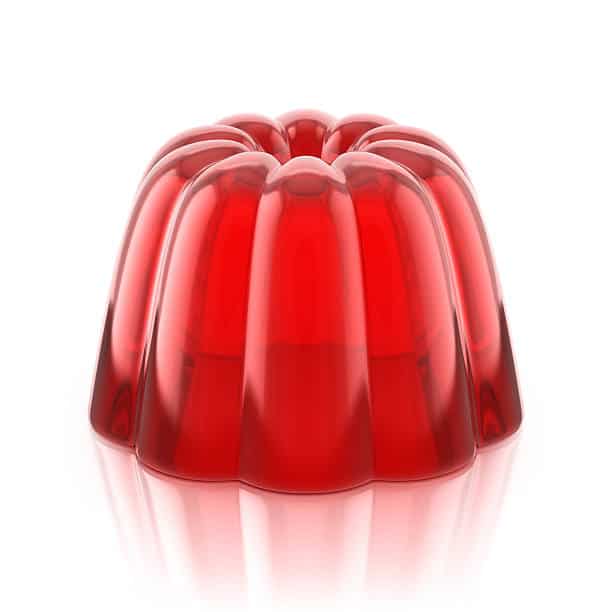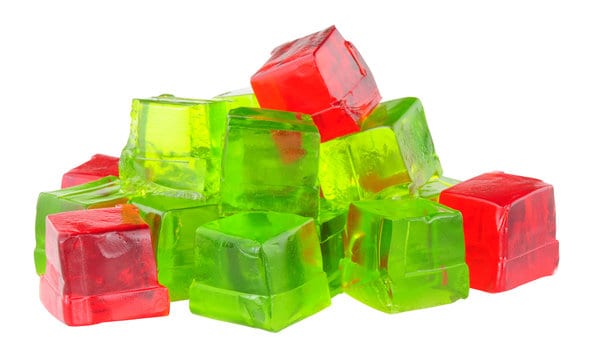Watching your pets stare at you wide-eyed while you enjoy a treat isn’t a comfortable situation for most people. Dog lovers who truly care about their pets often give in and share their meals with them. If you are like me, though, you probably wonder often whether your human meal is safe and healthy for them. After watching my dog crave desperately for my jello while I ate, I became pressed to find out whether or not dogs could eat jello. Here’s what I found out:
Dogs can eat jellos in small quantities, on the condition that it is served occasionally, free from much sugar and artificial sweeteners, especially the notorious xylitol, which has been proven to kill dogs. Store-bought jello contains artificial sweeteners and sugar content which are not healthy for dogs. Jello can be safely prepared at home and served as treats to dogs.
Serving jello to your dog comes with many preventable but serious risks that can be incurred if it’s not done properly. Much care has to be taken and details observed if your dog is to feed on jellos safely. In this article, you will learn, amongst other things, the possibly harmful ingredients in jello, the beneficial ingredients, how to prepare healthy jello in an easy way, what to do if your dog eats harmful jello, and how gelatinous jello can be used to treat seizures.
What Is Jello?
Jello is a popular, sweet, wiggly-textured dessert that comes in various exciting colors and flavors. It is made primarily from gelatin. Gelatin is a proteinous substance made from animal collagen, a protein that makes up connective tissues like skin.
Gelatin is usually gotten when the hides and bones of certain animals such as cows are boiled, dried, then treated with a strong acid or base and filtered to extract the collagen. After this, the collagen is dried, ground into a powder, and sieved to make gelatin.
You can get jello as a powdered mix that can be made at home, or as an already made dessert mostly sold in individual cup-sized servings.
Jello has a characteristic jiggly and gel-like texture. At home, this is gotten by dissolving the mixture in boiling water. The heat helps to break the bonds that hold the collagen together. Upon cooling, it reforms to a semi-solid state, a gel with water molecules trapped inside.
Ingredients of Jello That Make It Unsuitable for Dogs
Other than gelatin, there are other ingredients such as sweeteners, flavoring agents, and even colorings that are usually added to make jello.
Aspartame is the sweetener usually used in jello. It is an artificial calorie-free sugar.
Both natural or artificial colorings can be used in jello. Artificial flavors are chemical mixtures that mimic natural flavors. Most times, manufacturers add chemicals to the jello until they accomplish the desired flavor profile.
These colorings and artificial sweeteners like xylitol make it unhealthy for your dog’s consumption.
Since jello is made from gelatin, which is made from animal hides and bones, jello is not considered vegetarian or vegan.
If you are a vegetarian, do not despair; vegetarian jello is available in stores. They are made from plant-based gums or seaweeds, like agar or carrageenan.
For DIY home recipes of healthy jello that you can feed your dog, keep reading.

Jello: Nutritional Information
The following nutritional information details the nutrient profile for a 100g serving of jello.
Calories: 62g
Carbohydrate: 13.4g
Protein: 1.2g
Fat: 0g
Cholesterol: 0g
Sodium: 75mg
Potassium: 1mg
Fiber: 0g
Sugar: 13g
Jello: Health Benefits To Dogs
Carbohydrates: Canines need all the energy they can get to play and live life to the fullest. Carbohydrates are especially important as a source of internal heat if the dog lives in a cold region. Alongside this, it acts as a facilitator for other nutrients in the body, helping them perform at optimum levels.
Jello can be trusted to provide a generous share of your dog’s daily carb needs.
Protein: Every dog lover wants healthy hair and skin for their dog. Jello provides protein for this by giving the skin cells much-needed support, alongside boosting the immune system of your dog and enabling healthy muscles and tissues.
Sodium: Your dog’s nerves will function at the highest levels when their diet contains the right amount of sodium, which jello provides. It also contributes to pristine muscle functions.
Potassium: If your dog ever happens to have a battle with lethargy, frequent thirst and urination, constipation, and vomiting, then it is most likely a result of potassium deficiency. Jello will provide your dog with the potassium it needs to maintain healthy organs and muscles, boost digestion and nutrient absorption, and keep its cognitive functions at an optimal level.
Jello and The Treatment of seizures and Arthritis
Thanks to the gelatin content of jello, it has proven to be an effective remedy to seizures in dogs. Glycine, a potent amino acid present in gelatin, is widely acclaimed to have high success in countering dog seizures and brain damage. If your dog is dealing with seizures, you might want to introduce jello as soon as possible because for every haul experienced by a dog, the chances of having another increase.
How To Prepare Jello For Dogs
The importance of keeping premade, store-bought jello away from your dogs cannot be overemphasized. This is because of the artificial sweetener xylitol present in it, which is unsafe for your dog.
However, plain, unflavored, and unsweetened gelatin is safe for your dog and also promises numerous health benefits. One jello dog recipe you can prepare for your dog is the chicken jello dog treat recipe.
This treat screams protein, protein, and more protein. A completely healthy choice. Here are some recipes that dog lovers can try:
A Safe and Healthy Do It Yourself Jello Recipe
Ingredients
Plain, unflavoured, and unsweetened gelatin powder.
0.1 kg or 1/4 pound fat trimmed chicken breast,
One large washed, peeled, and chopped carrot,
Five parsley leaves,
Flavor
water
Method
Let the parsley, chicken breast, and chopped carrot(with your desired flavor)boil in enough water to cover them till they are soft.
Remove the chicken breasts and carrots from the broth and blend to smoothness.
Whisk gelatin in a half or three-quarter cup of the chicken broth until fully mixed.
Mix blended gelatin-chicken broth with the blended chicken breast and carrot. Stir till it is smooth.
Pour into a bowl or pan of the desired shape and refrigerate.
When it fully sets, remove the jello treat from the mold and store it in an airtight container in the refrigerator for up to 3 days.
Dish an appropriate or moderate amount for your dog.
When your dog gets a taste of this treat, it’s going to adore you a lot more! Plus, you’ll be left satisfied and assured that you’re feeding your dog a super-healthy diet.
For a less complicated jello treat, pour one-quarter cup of cold water in a bowl.
Add a tablespoon of gelatin followed by a one-quarter cup of hot water.
Add your desired flavoring and whisk till it all mixes perfectly.
Refrigerate for three days.
How Much Jello Should I Give To My Dogs?
There’s some controversy over the appropriate amount of jello that dogs should be fed. No fixed amount is the right amount as dogs are of different sizes and can only cope with an amount that corresponds to their size.
However, the general rule is to make jello an occasional treat (at most three times a week) and serve as little as possible.
Are Dogs Allergic To Jello?
Dogs can experience allergic reactions to jello even when it is devoid of sweeteners and other toxic additives. For this reason, introducing jello slowly and moderately to your dog’s diet remains the safest way to go.
While jello is being introduced to your dog, it is necessary to closely observe them for any signs of possible allergies.
The symptoms of allergies in canines include
- restlessness
- Diarrhea
- Itchy ears
- Frequent or chronic sneezing
- Red skin
- Vomiting and
- Swelling
Once several of these symptoms are noticed after introducing jello to your dogs, that’s a red flag. This means no more jello!

How to Treat Jello allergies in Dogs
Treating allergic reactions to jello in your dog is no different from treating all other forms of dog allergies. Diphenhydramine, also known as Benadryl, can be used under the direction of a veterinary doctor to treat allergic symptoms in dogs. Your dog’s allergies should begin to reduce after 3 to 4 hours.
A vet’s direction is important in treating allergies in dogs, especially in the area of dosage. Smaller dogs require smaller doses than larger ones. Experts have, however, prescribed between 2 to 4 milligrams of Benadryl for every one-kilogram weight of a dog to be administered twice daily for mild allergic symptoms and thrice daily for more serious cases.
FAQ
1. What Fruits Can Dogs Eat?
Fresh fruits can serve as a healthy diet for your dog, so long as you know the right kinds of fruits that should be included in your pet’s fruit bowl.
What Fruits can dogs eat? Dogs can eat Apples, bananas, blueberries, blackberries, raspberries, pears, tomatoes, apricots, peaches, and plums.
Apples- “an apple a day keeps the doctor away.” This saying only applies to the skin and flesh of apples. Including apple pips with traces of cyanide in a dog’s diet would be the easiest way to endanger your dog’s health.
Bananas have a lot of nutritional content. They are rich in potassium and carbohydrates. Take care to serve sparingly because of their high sugar content. Blueberries, blackberries, and raspberries are all-around nutritional packages and health-boosting antioxidants.
Serve in small amounts, either fresh or frozen, as determined by your dog’s preference. Pears, tomatoes, apricots, peaches, and plums are all fruits you can feed your dog. Remember to remove the pips and ensure that the tomatoes are fully ripe and served in moderation.
2. Can Dogs Eat Jello Pudding?
No! Dogs shouldn’t eat jello pudding, except for homemade jello pudding.
Jello pudding contains xylitol, which is hazardous to your dog’s health, as it causes hypoglycemia in dogs.
3. Can Dogs Eat Jell-O Without Sugar?
No, dogs cannot eat Jell-O without sugar. It has artificial sweeteners like xylitol, which is unhealthy and toxic for canines. Its gelatin content is the primary reason why jello is considered for inclusion in a dog’s diet plan.
Asides from gelatin, jello contains little or no other nutritional benefits for your dogs.
4. What Happens If A Dog Eats Jell-O?
The dangers associated with feeding your dog with the Jell-O brand can be summarised in one word— Xylitol.
The health risks of xylitol are hazardous; it is poisonous in every sense.
The first 30 minutes of your pet’s consumption of jello containing xylitol is crucial. It strongly stimulates the production of insulin. Even the tiniest amount (0.1g/kg) is enough to reduce your pet’s sugar level drastically. This is dangerous as it could cause hypoglycemia leading to seizures, coma, or even the worst of them all—death.
An alternative is a homemade healthy jello dessert consisting of fruits, gelatin, and honey, a natural sweetener.
5. Is Jello Toxic To Dogs?
Yes, if it contains artificial sweeteners, especially the dreaded xylitol! Ever had the urge to share that squishy, delicious, and sugary jello treats with your pup?
The consequences could be dire and, in some cases, fatal, except you can take care to ensure that it is free from any chemical that isn’t friendly to your dog’s health. The surest way to separate these toxic substances from your dog is to make it yourself.
6. Can My Dog Eat Strawberry Jello?
Yes, your dog can eat strawberry jello. But hold on a second! Before you rush down to the store to get jello that could be disastrous to your dog’s health, you should know that buying jello from a supermarket for your dog is a bad idea, the reason being that you are not sure of its content, nutritional values, and the consequences of its consumption.
Strawberry jello made with fresh strawberries and gelatin is the only jelly I can recommend you feed your dog. Buying a pre-packaged strawberry jello mix from the store could be bad for your dog.
So, in a nutshell, jello is safe, only when it’s homemade, sugar, sweetener, and additive-free.
7. Can Dogs Eat Jelly?
No, dogs shouldn’t be fed jelly, as the high sugar content of jelly holds no nutritional value for dogs. Consuming a lot of sugar can cause inflammation and lead to diabetes or worse health problems in dogs.
Jellies consist of fruits like strawberries, raspberries, and blueberries, you may say. Doesn’t this make it safe for my dog to enjoy as a treat?
The answer is no. When jellies are produced, they are heated to a high temperature. This reduces the nutritional values of the fruits in them. Also, xylitol, an artificial sweetener present in jelly, is toxic to dogs.
Conclusion
Dogs can eat jello that is free from artificial flavoring and sweeteners. These chemicals are to be avoided because they are very toxic to the health of dogs. Xylitol, an artificial jello sweetener, must be avoided at all costs as it is responsible for harmful side effects to dogs’ health, sometimes even leading to death.
Dogs can be allergic to jello even when there are no harmful chemicals in them, so they must be properly observed. In contrast, jello is introduced moderately to their diet. Symptoms of jello allergies can be treated with Diphenhydramine after consulting a vet.
Gelatin, the most prominent jello ingredient, provides dogs with a host of substantial benefits. Jello can be made at home to avoid those that contain chemicals that are toxic to dogs.


